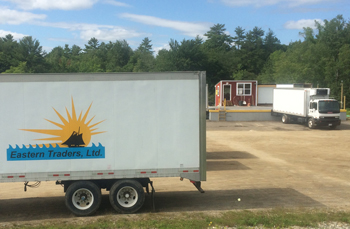International Lobster Marketplace a Shifting Landscape for Maine Company

Rick Wahle, University of Maine School of Marine Science. From 1982 to the early aughts, GOM water temperature increased about 2 degrees F every 40 years. Since 2004, that’s ramped up 10-fold, to an increase of 2 degrees F every four years. The North Atlantic in particular has been warming at a more rapid rate than the rest of the globe’s oceans. Fishermen’s Voice photo
Alongside harvesting, at the heart of the lobster business is the trading of lobster. Lobstermen catch them and traders move them through the marketplace. Neither necessarily knows how the other does what they do, but they are both dependent on each other’s skills. This multimillion-dollar business runs on increments of a few cents a pound per trade.
Eastern Traders is a Nobleboro company that moves lobster through the marketplace. In some ways it’s in a niche market, a big niche, supplying lobster to Canadian processors. Eastern Traders president Kerin Resch said his company is currently shipping more than 10 million pounds of lobster a year through that market. Eastern Traders has a tractor-trailer and nine straight trucks on the road.
“Demand,” said Resch, “is not from Canada but from the world. Canada is the facilitator, having had the infrastructure in place for generations.”
Resch said Canada saw the need for infrastructure and created an environment to do a tremendous business. Processors in Canada send product largely to high-volume U.S. companies such as Red Lobster.
Currently, prices and volume are up, and the lobster market is good. But it hasn’t always been that way. Not long ago, Canadian lobstermen barricaded Canadian roads and turned back trucks loaded with American lobster. Maine lobstermen complained that Canadian processors were driving down the price of lobster.
Resch said he was there through it all. He started in 1984 in the wholesale byproduct business. His first truck was a $500 Chevy pick-up with a camper. There were times when he had collect money owed to him. “In this business, it’s very easy to get in over your head, in what is owed to whom, and coming up short on cash to pay debts is not uncommon,” he said.
Resch was looking for reliable sources and cash flow when he approached a Canadian processing company with a proposal. Suppliers would typically call processing plants and offer lobster shipments. The company Resch called had recently made a deal with a supplier for a large shipment of lobster. The company brought in 300 workers to process the shipment, but the supplier sold his lobster to the highest bidder and left the processor high and dry.
That led Eastern Traders to a long-term business relationship with the Canadian company. That came to plant upgrades, increased capacity and product changes, Resch said.
“They tell us what they need and we go find it,” he said.
Resch said he buys as far as the south shore of Massachusetts and all of Maine, consolidating lobster supplies at two collection facilities in Maine, icing down the product, and then immediately shipping it to Canada. Eastern Traders closed their tank facility four years ago, built an ice plant and now ships the same day in refrigerated trucks.
Eastern Traders ships boat run, process grade, air freight grade and chix. They also take orders for specific sizes and volume. Over the last three to four years, the Chinese have been buying a lot of lobster. “They seem insatiable,” said Resch. “Not for the processed tails and meat, but for whole cooked or frozen. More than 30 million Chinese rise out of poverty every year, a number equal to the population of Canada.” Resch said the influence of the Chinese market on the lobster industry is enormous, producing demand and price swings like nothing the market has seen before.
Resch said, “A Canadian company took over a large processor in the Maritimes a few years ago, but they didn’t have a good marketing plan and they ran out of money. They took their very large inventory and dumped it in China. This enormous amount of North Atlantic cold water lobster, perhaps 20 million pounds after processing, was sold at a very low price. But it helped jump start an interest in this kind of lobster in China.”
About the lobster business, Resch said, “The supply chain needs to remain strong. The harvester has to make enough to support a family, as does everyone along the supply chain. Every link needs to make enough money to stay in business. If one link makes far too much, it weakens all the others. If the price to the customer is too high, we lose the customer. If the harvester does not make enough, we lose the supply.”
